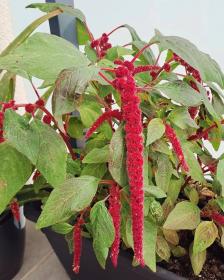Amaranthus caudatus is a plant with beautiful flowers and a rich history. It is used in unique ways in various cultures. The common name Amaranth comes from the Greek word for “never-fading flower.”
Amaranth is an herb, not a “true” grain, and is a relative of the garden plant Cockscomb and the common wild plant lamb’s-quarters. Typical Amaranth plants are bushy, growing 5-7 feet tall, with broad leaves and displaying a bright, showy flower head of small, red, or magenta clover-like flowers that constitute the plant’s exquisite, feathery plumes.
Amaranthus caudatus seed heads are also quite striking, resembling corn tassels but somewhat fuller. Aside from being such an attractive plant, Amaranth is highly adaptable to adverse growing conditions, resisting heat and drought, and is extremely easy to grow.
Thanks to its robust nature, Amaranthus caudatus was a staple food in the diets of pre-Colombian Aztecs. These people believed it had supernatural powers and incorporated it into their religious ceremonies. In Mexico, it is popped and mixed with a sugar solution to make a confection called “Alegria” (happiness). In India, Amaranth is known as “Rajeera” (the King’s grain) and is used in confections called “laddoos,” which are similar to Mexican “Alegria.”Peruvians use fermented Amaranthus caudatus seeds to make “chicha,” or beer. In the Cusco area, the flowers are used to treat toothaches and fevers and as a food colorant for maize and quinoa. In Nepal, amaranth seeds are eaten as gruel called “Sattoo” or milled into flour to make chapatis. In Ecuador, the flowers are boiled, and the colored boiling water is added to “Aquateinte” rum to create a drink that “purifies the blood.”
Amaranth has been gaining popularity in the U.S. Although it is now grown in Colorado, Illinois, Nebraska, and other states, it is still not a mainstream food. It is found in many natural food stores, and the flour is often used in baked goods.
